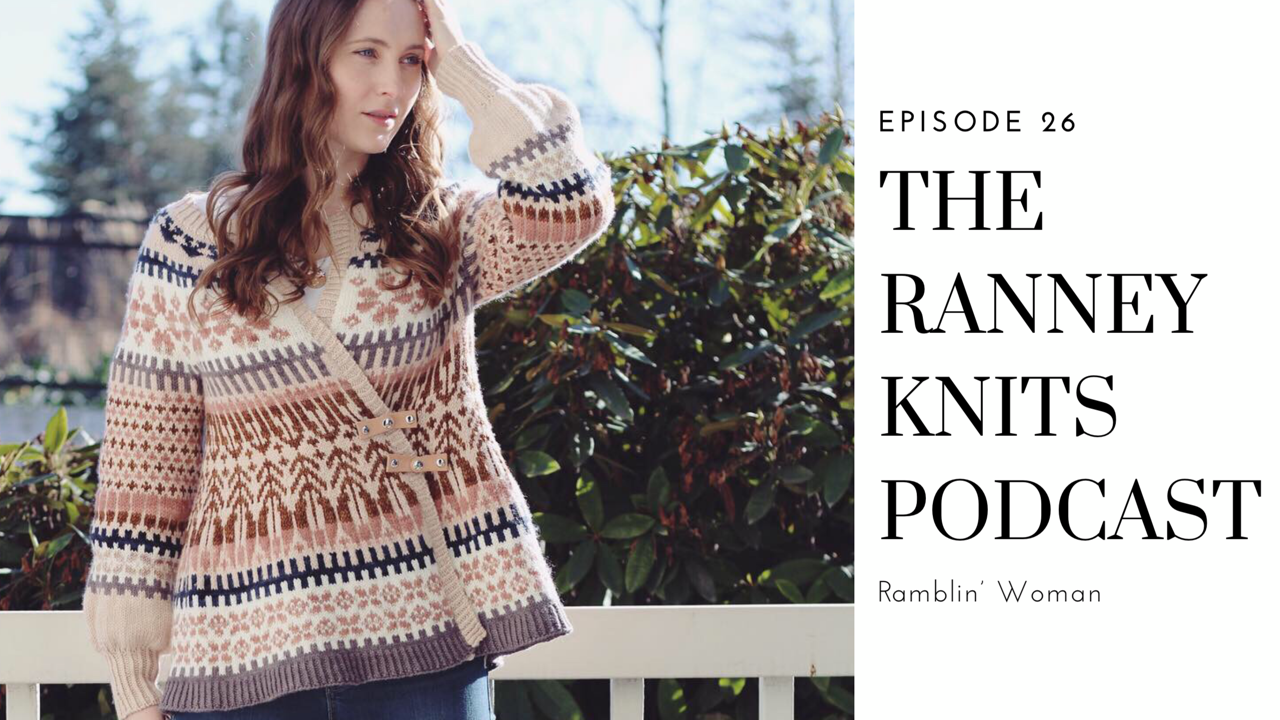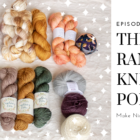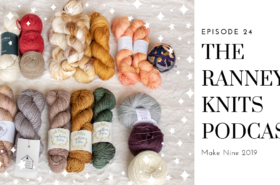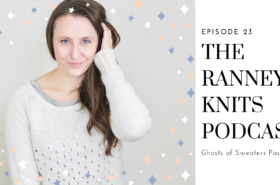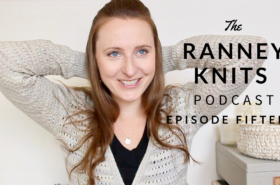Quick Links
Vox Article on racism in the knitting community
https://www.vox.com/the-goods/2019/2/25/18234950/knitting-racism-instagram-stories
Ramblin Woman Cardigan
https://www.ravelry.com/projects/ranneyknits/ramblin-woman
Dying yarn with avocado
https://www.youtube.com/watch?v=gxSoQk86Xec
Dank Fiber
https://www.instagram.com/dankfiber/?hl=en
Books & Cables Podcast
https://www.youtube.com/watch?v=XzEAw41_Xic
It’s not about the hat by Susan Rainey
https://www.ravelry.com/patterns/library/its-not-about-the-hat
Steeking Resources
https://blog.tincanknits.com/2014/09/18/steek/
Slip stitch crochet reinforcement
https://www.youtube.com/watch?v=2cn5tiy3XPk
Hi, welcome to the Ranney Knits podcast! My name is Justine and this is my knitting podcast. I’m trying something new and writing a full blog post to accompany each podcast episode, so if you prefer to read you can find it at ranneyknits.com/podcast
I am on Instagram and Ravelry as ranneyknits, and there is a group for the podcast on Ravelry, find it by searching “Ranney Knits Podcast” or click the link in the down bar.
It’s been a minute since my last podcast episode. Yesterday I thought, “I’m just going to take a break from podcasting in January,” but then I realized it’s not January anymore! How did that happen? It was a busy month for me, I started a new job and that has cut down my knitting time dramatically. Luckily, that is one of the only downsides, the job is fun and the people I’m working with are wonderful.
Before I go further, I want to address the conversation that has been happening on social media regarding race, diversity, and inclusion, specifically in the knitting community but also in other online communities and in our lives outside of the internet. It is such a necessary discussion and one that shouldn’t have taken us this long to start. The people who continue to speak out about this issue have done a lot of difficult work and shared their pain with us so that people like me will pay attention.
I have failed people of color, people with disabilities, members of the LGBTQ community. I’ve been ignorant to much of the racism, homophobia, ableism, xenophobia, and transphobia that happens in our cozy little knitting community. If you are a person who wants to ignore this conversation and escape from it through knitting, this space isn’t for you.
If you are working to dismantle the systems that allow hate to continue, thank you.
If you’ve been made to feel excluded or in any way unwelcome in this space, I am sorry. I will be doing my best to make it clear this is a welcoming space for everyone, but accept that I will make mistakes. If I say anything that hurts you or makes you feel excluded and you are gracious enough to tell me, please know you will be listened to.
I’m here for conversations, you don’t have to agree with me on absolutely everything in order for us to remain friends, so long as we agree racism, homophobia, ableism, xenophobia, and transphobia are not political issues or one-sided opinions.
This is a hard transition because I don’t want to say all that and then go, “Ok! on to the knitting!” But this is a knitting podcast and I have been doing a little bit of knitting in the last month.
I just have one project I’m going to talk about today and that is the Ramblin’ Woman Cardigan by Caitlin Hunter (Boyland Knitworks).
This is a project I’ve been dreaming of making for a while now. It is one of my Make Nine projects, and I’m planning on taking it with me to the Edinburgh Yarn Festival later this month!
I’m using yarn from a few different dyers on several different bases. Most of it is DK weight yarn, with the exception of the white, which is two strands of fingering weight held together.
All the info about the yarn can be found on my Ravelry page, but I’ll go through each one quickly.
The blue, pink, and grey are from Knitcraft and Knittery. It’s 100% Australian Merino Wool
The rust is from Explorer Knits + Fibers, this was leftovers from the Tecumseh I made for her as a sample. It’s 100% SW Merino
The lighter pink is from Earl Grey Fiber Co. 100% SW Merino.
The beige and the white are from Knit Picks, they are both 85% Merino 15% Cashmere. The white is their Capretta base, which is a fingering weight that I held double. The beige is on their DK weight Capera base. I bought this yarn during the Knit Picks November sale, I had a different plan for the fingering weight, but I picked up the DK weight because it was a great deal and I thought it would be a good yarn to dye. So to get this color I used avocado pits and skins, and it didn’t exactly turn out the way I had hoped, but it was a much more successful experiment than the first time I tried dying with avocados. At least you can tell I dyed it!
The yarn for this sweater cost me about $150. When I was purchasing yarn I made the mistake of not paying close attention to the yardage requirements for each color, and when I was all ready to start knitting I realized I didn’t have enough yardage for CC1. Rather than purchasing more yarn, I just played with the color work to maximize my yardage. I alternated between blue & gray for C1, I used the same color for C5 & C6 (the dark pink), and when I ran out of the dark pink I used C4 for the last chart of the sleeves. It took a little bit of math and (honestly) some luck, but it worked out!
This is the first time I’ve made anything that needs to be steeked, which is a technique that allows you to knit an item in the round, and then cut the fabric after you are done knitting. It is ideal for a colorwork cardigan because you don’t have to alternate between knitting and purling rows while also following the colorwork charts.
I used a couple of techniques that were new to me in this garment. Neither of these is written in the pattern, I picked them up from two very helpful knitters on Instagram. The fist is the way I made my increases. For the yoke, the increase rows have you adding a lot of stitches all at once. For example, after every 2nd stitch, or 3rd stitch. It’s suggested you do a make one left, so making a stitch by picking up the bar in between two stitches. I prefer this increase over the knitting through the back loop method, but M1L still makes a little hole in your work. It’s fine if you’re just increasing a few stitches per row, but when increasing 50, 60, 70 stitches, those little holes become very noticeable. So dank fiber on Instagram knits a lot of Caitlin Hunter patterns, she’s a sample knitting goddess and such an incredible knitter. She has a video tutorial in her Instagram stories on how to make an increase with no holes. Basically, when you want to make an increase you slip the next stitch and pick up the left side of the stitch directly under the stitch you just slipped, and knit your new stitch. You do need an Instagram account to find her video, it’s in her stories labeled “No Holes!”
The other new technique I learned comes from Heidi of the Books and Cables podcast. Her podcast is so full of information about knitting, if you want to learn a lot I highly recommend checking it out. She knows so much about knitting and she’s always trying out new techniques, I learn something new in every episode. She knit a gorgeous Ramblin’ Woman cardigan and introduced me to a great way to catch long floats. Floats are the longer strands of yarn that are carried on the back when they’re not being knit in stranded colorwork. It’s often suggested to wrap or twist these floats with the working yarn in order to keep them from sticking out too much. I don’t wrap my floats because it’s a hassle and I don’t like the way it looks, it often makes the fabric tighter and the twisted parts poke through to the right side of the work. I prefer to just be careful and not stick my finger through the floats while wearing the garment. The way I wrapped my extra long floats in this cardigan is called Invisible Stranding, and it is part of a paid for pattern, so I can’t tell you exactly how it’s done, but it’s super easy! The pattern is “It’s not about the hat” by Susan Rainey (No relation. She sensibly spells her name the way that English speakers have no trouble pronouncing. Rather than with extra ’N’s that for some reason my ancestors thought were necessary.) The pattern is for a hat that uses this technique to manage floats, and it includes lots of instructions, photos, and a link to a video tutorial. It makes a nice row of knit stitches that manage the floats on the wrong side and is invisible on the right side. How cool is that?
My first steeking experience was terrifying. I used the crochet reinforcement technique that was suggested in the pattern.
This reinforcement worked fairly well, but some of my ends still fell out and looked like there was potential for them to unravel. I panicked and did a lot of google searching for what to do if your steek reinforcement fails. I found a second crochet reinforcement called the slip-stitch crochet reinforcement that made me feel a little more confident that my sweater isn’t going to fall apart.
I’m planning on sewing a ribbon over the steek panel flap as a final, finishing touch.
There are instructions for an optional belt in this pattern, but I was worried that if I wanted to take the belt off and wear the cardigan open I would end up losing the belt. My first idea was to sew the belt on or making loops to thread it through (like the belt on a bathrobe). However, I didn’t want to cover up the color work on the back, and that would still leave the belt hanging when I was wearing it open. My solution, in the end, was to purchase some leather latch closures from Jul Designs. These closures have a snap in the middle and screw into either side of the cardigan’s opening. I like these closures because you can unscrew and reposition them, or use them on multiple projects. The closures I chose to have two per package, which I didn’t realize and ended up buying two packages, so I have four closures in total.
I’m excited to wear this cardigan at EYF! If you are going to be a the festival I would love to connect with you in person! As far as the podcast/ youtube channel goes, I am planning on vlogging during my trip & at the festival. There won’t be another podcast in March. Hopefully, I will post a new episode in April! Thanks for tuning in, happy knitting!

